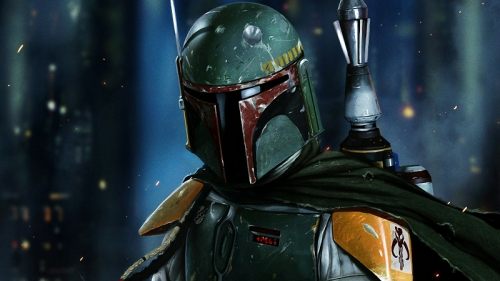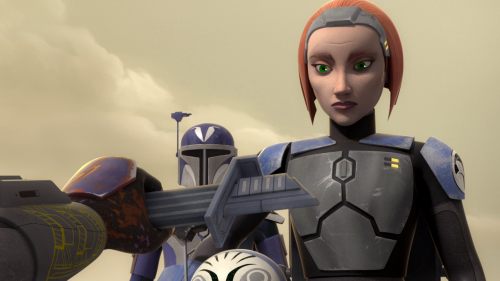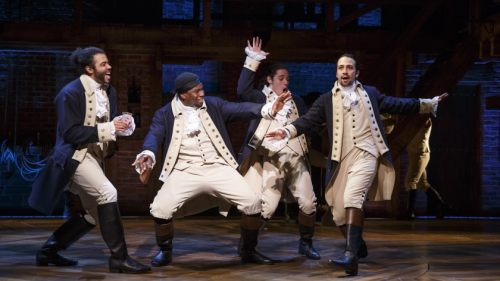THE MANDALORIAN’s Slavish Relationship With Iconography
The Mandalorian has a curious relationship with iconography. Being a latter-day Star Wars product, it's packed full of imagery designed to set off our pleasure centres. But surprisingly, Star Wars is not the principal source of The Mandalorian’s iconography. Rather, that role falls to the Western genre - a genre whose conventions do almost all the narrative heavy lifting in Disney's flagship streaming show.
In terms of Star Wars stuff, there's plenty to talk about. Despite attempts to individualise its main character, the show plays heavily on the popularity of Boba Fett, who - even after gaining some humanity in Attack of the Clones - has always been a bit of a cipher. The Mandalorian’s Mandalorian is a similarly empty costume thus far, save for a few quips and some solid physicality work on the part of (presumably) Pedro Pascal. Concealing Pascal’s face makes the entire first episode - hell, even the first two- play out like an extended cold open. The show feels lonely, and not just because the Mandalorian is a lone warrior. We’re lonely, without a human face to draw us in. It’s a serious issue when your lead character is 90% defined by a cool look inherited from a different character.
The Mandalorian's world is likewise filled with familiar Star Wars iconography. We see Kowakian monkey-lizards (but not Salacious Crumb, just as the Mandalorian himself isn’t Boba Fett) in a bazaar that feels an awful lot like Mos Eisley or Mos Espa. Likewise, "Chapter One"'s IG-11 and "Chapter Two"'s Trandoshans might as well be IG-88 and Bossk from The Empire Strikes Back. The gatekeeper droid from Return of the Jedi greets the Mandalorian as he visits a client, and a gonk droid escorts him down a corridor. The Mandalorian freezes his bounties in carbonite (a technology that has obviously undergone significant miniaturisation since Empire). Even the Star Wars Holiday Special gets a shoutout, and somehow, even this show about a faceless bounty hunter manages to become a show about yet another familiar-looking merch-friendly Force-wielder, set in yet another fucking desert.
But for all its reliance on Star Wars iconography, none of that really carries the story. What does have a bit more storytelling significance is the Western imagery that permeates every scene thus far. That begins with the Mandalorian himself. He’s the Star Wars equivalent of the Man With No Name, right down to...having no name: largely silent, getting by on a frontier where life is cheap, occasionally engaging in rivalry or uneasy collaboration with fellow bounty hunters. He is introduced as a silhouette in futuristic saloon doors (followed by a a barroom brawl and even a bartender sliding a drink along a bar). The story takes us to a remote outlaw hideout. A shootout concludes with a pretty blatant Wild Bunch homage. The Wild West is everywhere in this corner of the galaxy far far away.
"Chapter One" boasts a lengthy scene in which the Mandalorian tames a wild mount, in keeping with episode director and Rebels showrunner Dave Filoni’s passion for space animal husbandry. In a real Western at the genre’s peak, Nick Nolte’s character would have been a lone grizzled rancher. The Jawas would be passing Native American traders; their sandcrawler, a covered wagon or some such thing. Nearly everything in the show can be seen as a one-to-one substitution from the Western genre, right down to Ludwig Goransson’s space-Morricone soundtrack.
And yet, even all that is essentially shorthand. The Mandalorian lurches through a thin plot from signpost to signpost, giving the illusion of story without ever investigating its core character. There's plenty of stuff onscreen, but so far there's no "why" or "who" to the show, and that's a killer. Without any substance, all we have is the (admittedly gorgeous) style. So far, the only prominent story development has centred on the baby Yoda, whose Force sensitivity is a tired decision on arrival; apart from that, not a single one of the exciting, flashy setpieces has really had any stakes.
In spite of Disney’s decision to release The Mandalorian week-by-week, the first two episodes curiously provide a strong case for lump-sum binge-watching. Regular shows' premieres are typically full of narrative and character hooks to encourage recurring viewership. With binge-oriented shows, there’s already an assumption of continued viewing, so the traditional rules of engagement don’t apply as much. The Mandalorian oozes confidence in that assumption. Of course, in this case it's is probably warranted, as it’s a) Star Wars, b) incredibly heavily marketed, and c) likely the primary reason many a exist in the first place.
The flipside of this, of course, is that The Mandalorian is beautiful to behold, sporting a dizzying array of striking compositions and tableaus. It ought to be; at a reported 15 million dollars per near-aimless half-hour episode, it’s easily the most expensive show per minute in history (Game of Thrones ran similar budgets, but at one-hour-plus episode lengths). The Mandalorian can be read as the most cinematic material Star Wars has seen since the original, telling its story purely visually as opposed to through dialogue. This is true - dialogue is minimal, and we intuit much of the character’s routine and attitude through action - but we still don’t get a look at the best visual storytelling tool of all: the human face.
There's another kind of Star Wars product that does all this: fan films. Often made to showcase costumes, props, or makeup, or to demo the creator’s visual effects prowess, fan films tend to revolve around action and design more than character and story. That’s understandable, given that the projects are often led by VFX artists, and only in rare cases attract professional actors capable of carrying drama. Fan filmmakers understandably want to re-enact the coolest stuff in the saga, which almost invariably means lightsaber duels, spaceship battles, and characters shrouded in robes and helmets. The Mandalorian feels, so far, like the best-shot, most polished fan film ever made, right down to its lack of dialogue. "Isn't this cool," it seems to be saying.
Thing is: it is cool. This is what many viewers want out of Star Wars. I’ve seen numerous comments on social media breathless with praise for The Mandalorian, even claiming it's the best Star Wars since the Disney buyout. Some of those people will be saying so due to the lack of female characters (though hoo boy, isn’t that baby Yoda a Mary Sue, using those Force powers without training?), but most are simply happy to see all that Star Wars shit onscreen. And hell, so am I. On a surface level, The Mandalorian is extremely entertaining, especially for committed Star Wars fans, and I've been having a great time watching it. But afterwards, it leaves me feeling hollow inside. So far, The Mandalorian is the Star Wars equivalent of porn: an embarrassingly generous portion of things you get off on seeing, where the story is secondary to the money shots.
It remains to be seen whether The Mandalorian sticks to this iconography-first approach, now the show has escaped its starting scenario. I have to assume Pascal’s helmet will come off eventually; you don’t hire that beautiful man in order to not show his face. We’ve seen the Mandalorian show begrudging affection towards the Yoda child, which is nice; it’d be nice to get some deeper characterisation. Until then, all we have is helmets, blasters, Jawas, and sand. Lots and lots of sand.
And I don’t like sand.



